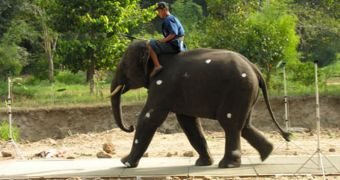Scientists propose that large elephants may not be running, regardless of how fast they appear to be moving. A series of investigations has made experts consider the possibility that the mammals may actually be walking very fast, rather than running in the strictest sense of the word. The new research appears to indicate that an elephant which is rushing actually walks and runs at the same time. Cataloging precisely what it does is very difficult, because these creatures tend to break all rules of how animals should move, ScienceNow reports.
Biologists explain that four-legged vertebrates have the tendency to exhibit visible differences between the strides they employ when walking and running. When moving for high speeds, they take all their four feet off the ground at the same time. This is absolutely false for elephants. The animals indeed take faster and longer steps, as any other creature running, but they never take all of their four feet off the ground at the same time. Experts hypothesize that this is an adaptation for distributing their massive weight on the ground in as many points as possible while not sacrificing speed.
Biomechanics expert Norman Heglund, from the Catholic University of Louvain, in Belgium, says that there are other factors to consider as well, in determining whether elephants run or not. He adds that changing strides also produces a number of changes in how other four-legged creatures move. The expert mentions that knees flexing different than usual cause a change in their centers of gravity, as well as in the maximum amount of force they can exert on the ground when pushing themselves against it. In smaller animals and in humans, measuring these changes is relatively easy, for the simple fact that we are lighter. But elephants weigh a few tons, so studying it like this is very difficult.
Heglund and his team therefore constructed a new type of heavy-duty force-sensing plate that they then shipped to the Thai Elephant Conservation Center, in the Lampang Province. The system was complete with computers and video cameras, and some 16 of the plates were used for the new investigation. In a paper just published in the current issue of The Journal of Experimental Biology, the researchers detail the results of their study, which saw 34 elephants being driven by trainers over the plates at various speeds.
“They don't really run in the classical sense. They can't quite kick it into second gear, so they're stuck halfway in between,” the researcher says. Slow-motion video showed that elephants tended to bend the knees on their front legs, but failed to do the same for their rear feet. Rigid knees are an indication of running, experts state.

 14 DAY TRIAL //
14 DAY TRIAL //